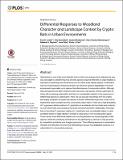Files in this item
Differential responses to woodland character and landscape context by cryptic bats in urban environments
Item metadata
| dc.contributor.author | Lintott, P.R. | |
| dc.contributor.author | Bunnefeld, N. | |
| dc.contributor.author | Minderman, J. | |
| dc.contributor.author | Fuentes-Montemayor, E. | |
| dc.contributor.author | Mayhew, R.J. | |
| dc.contributor.author | Olley, L. | |
| dc.contributor.author | Park, K.J. | |
| dc.date.accessioned | 2015-06-15T08:40:06Z | |
| dc.date.available | 2015-06-15T08:40:06Z | |
| dc.date.issued | 2015-05-15 | |
| dc.identifier | 195545507 | |
| dc.identifier | eee5acd0-77ad-4ff7-8878-004fd801c66f | |
| dc.identifier | 84929378757 | |
| dc.identifier | 000354916100107 | |
| dc.identifier.citation | Lintott , P R , Bunnefeld , N , Minderman , J , Fuentes-Montemayor , E , Mayhew , R J , Olley , L & Park , K J 2015 , ' Differential responses to woodland character and landscape context by cryptic bats in urban environments ' , PLoS One , vol. 10 , no. 5 , e0126850 . https://doi.org/10.1371/journal.pone.0126850 | en |
| dc.identifier.issn | 1932-6203 | |
| dc.identifier.uri | https://hdl.handle.net/10023/6823 | |
| dc.description | This research was funded by the University of Stirling (www.stir.ac.uk) and the British Ecological Society (Grant number: 3266 / 4045; http://www.britishecologicalsociety.org). | en |
| dc.description.abstract | Urbanisation is one of the most dramatic forms of land use change which relatively few species can adapt to. Determining how and why species respond differently to urban habitats is important in predicting future biodiversity loss as urban areas rapidly expand. Understanding how morphological or behavioural traits can influence species adaptability to the built environment may enable us to improve the effectiveness of conservation efforts. Although many bat species are able to exploit human resources, bat species richness generally declines with increasing urbanisation and there is considerable variation in the responses of different bat species to urbanisation. Here, we use acoustic recordings from two cryptic, and largely sympatric European bat species to assess differential responses in their use of fragmented urban woodland and the surrounding urban matrix. There was a high probability of P. pygmaeus activity relative to P. pipistrellus in woodlands with low clutter and understory cover which were surrounded by low levels of built environment. Additionally, the probability of recording P. pygmaeus relative to P. pipistrellus was considerably higher in urban woodland interior or edge habitat in contrast to urban grey or non-wooded green space. These results show differential habitat use occurring between two morphologically similar species; whilst the underlying mechanism for this partitioning is unknown it may be driven by competition avoidance over foraging resources. Their differing response to urbanisation indicates the difficulties involved when attempting to assess how adaptable a species is to urbanisation for conservation purposes. | |
| dc.format.extent | 1115741 | |
| dc.language.iso | eng | |
| dc.relation.ispartof | PLoS One | en |
| dc.subject | QH301 Biology | en |
| dc.subject | QL Zoology | en |
| dc.subject | SDG 11 - Sustainable Cities and Communities | en |
| dc.subject | SDG 15 - Life on Land | en |
| dc.subject.lcc | QH301 | en |
| dc.subject.lcc | QL | en |
| dc.title | Differential responses to woodland character and landscape context by cryptic bats in urban environments | en |
| dc.type | Journal article | en |
| dc.contributor.institution | University of St Andrews. School of Biology | en |
| dc.identifier.doi | 10.1371/journal.pone.0126850 | |
| dc.description.status | Peer reviewed | en |
| dc.identifier.url | http://journals.plos.org/plosone/article?id=10.1371/journal.pone.0126850#sec022 | en |
This item appears in the following Collection(s)
Items in the St Andrews Research Repository are protected by copyright, with all rights reserved, unless otherwise indicated.

